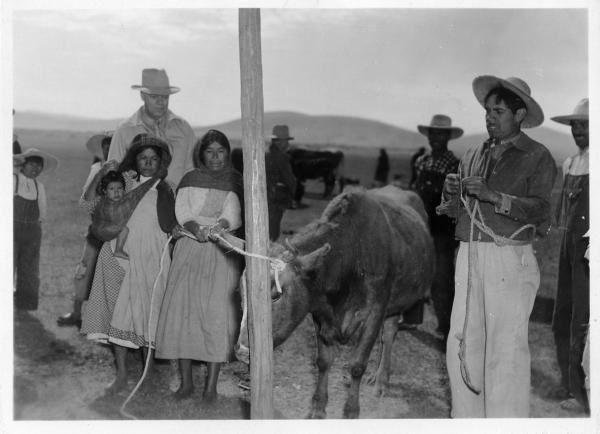
F. & M. Pix Mexico – From McClarren 12-8-49. Women securing cattle. USDA Bureau of Animal Industry Photograph Collection [Animal Science Institute (ASI) Archives], Collection 178. Border Patrol Pictures. MS178, Box 30. National Agricultural Library.
The United States Department of Agriculture (USDA) recently celebrated the 75th anniversary of the Mexico-U.S. Commission for Prevention of Foot-and-Mouth Disease. These celebrations, held in Mexico City, marked a crowning, bilateral achievement. They highlighted how this 1947, multi-national Commission was instrumental in containing and eradicating foot-and-mouth disease (FMD) in Mexico. (USDA, 2022, paras. 1)
This Story from the Collection, through the collections at the National Agricultural Library (NAL), invites readers to appreciate the complex history of foot-and-mouth disease and the relationship between the United States and Mexico. It briefly chronicles the 1946-1954 foot-and-mouth disease outbreak in Mexico and how the United States and Mexican governments worked together to eradicate the disease.
Using both primary and secondary sources, this telling embodies the ways that institutions like NAL contain, curate, and share histories within its collections that can shed light on the varied and dynamic, if at times fraught, experiences between national governments and local communities.
What follows includes a series of excerpts from primary and secondary sources, drawn from articles, books, historical documents, and also includes historical photographs, found within and outside of NAL.
Foot-and-Mouth Disease: Experiences and Materials Within NAL Collections
In the case of Mexico’s history, foot-and-mouth disease did not originate in the country; most experts believe that it was brought in from Brazil. A number of excerpts from scholars on this topic are included in this piece to further explain its origins and impact on Mexico, woven throughout the story. Not only do they provide more detail, but they also help to contextualize the story that the collections at NAL showcases.
Mary E. Mendoza is a historian of the United States-Mexico borderlands, the environment, and race relations in the United States in the 19th and 20th centuries. Using NAL collections in her own work, she describes foot-and-mouth disease and its origins. In “Battling Aftosa: North-to-South Migration across the U.S.-Mexico Border, 1947–1954," Mendoza describes the disease:
"Foot-and-Mouth Disease (FMD) or Aftosa (in Spanish) is one of the most virulent diseases that afflict cloven-hooved animals. Most animals that contract the disease develop blisters in their mouths, experience excessive salivation, suffer from high fevers, and often [develop mobility issues] because they lose their outer hooves completely. While fatality rates are low, the virus acutely affects meat and milk production." (Mendoza, 2015, p. 39)
She also chronicles movement of the disease:
“It started with a virus [among] Zebu cattle that arrived on the Mexican coast of Veracruz in mid-May 1946. The infected stock had come from Brazil. Tests were ordered to make sure they did not carry any infections before they disembarked onto Mexico’s mainland. After months of testing, the cattle was permitted to enter Mexico. However, by December 9, 1946, the [virus], which had evaded detection, had entered three Mexican states." (Mendoza, 2015, p. 39)
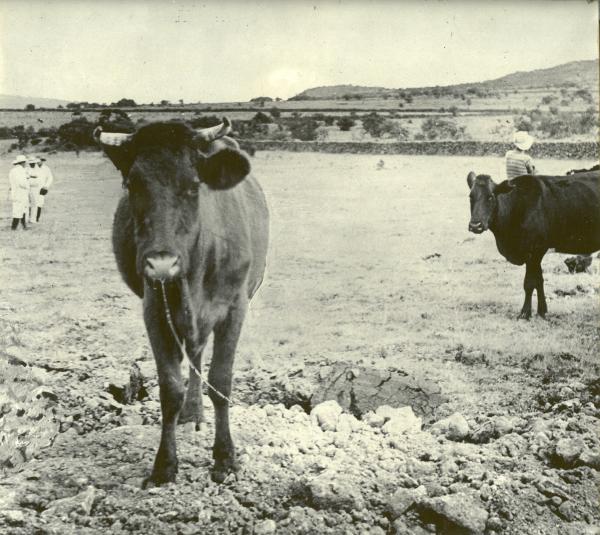
F. & M. – Mexico – 1949. 80225-B. Cow showing typical symptoms of foot-and-mouth disease.
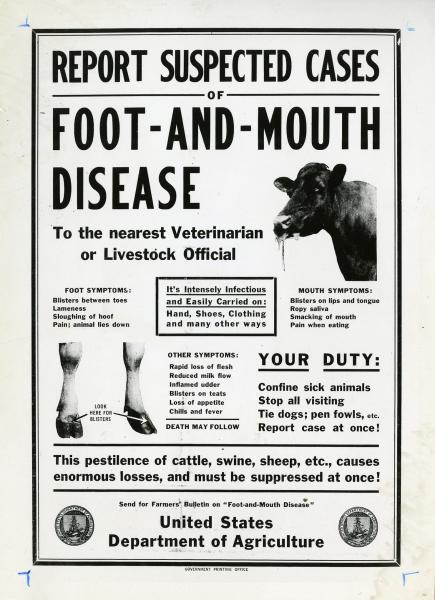
Report suspected cases poster. Historical Photography. Row 5 Draw 1, 23. Foot-and Mouth-Disease. Folder 1.
In “Burning the Archive, Building the State? Politics, Paper, and US Power in Postwar Mexico,” Thomas Rath explains how easily the disease spread: its high level of contagiousness was worrying as it could spread through livestock shipments, as well as dirt and dust gathered on clothes, goods and vehicles. (Rath, 2020, p. 770)
In addition to the health of livestock, foot-and-mouth disease also affected the trade operations of Mexico and the United States. The U.S. government feared that a full outbreak of foot-and-mouth disease on the United States side of the border would cost upwards of $200,000,000 a year. (Machado, 1969) As a preventative measure, livestock products were forbidden to enter and the United States-Mexico border was closed to Mexican cattle imports on December 26, 1946. Increased measures were taken to inspect other produce and goods traveling across the border into the United States.
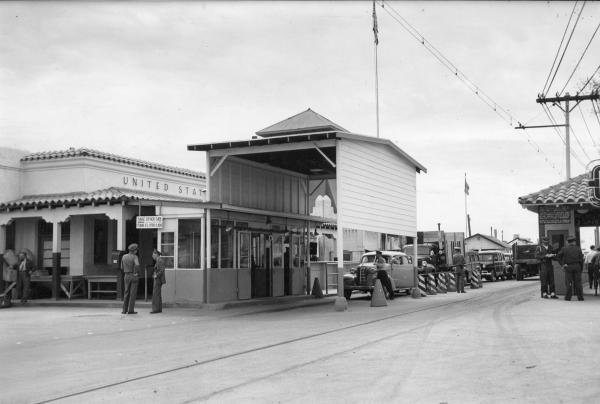
N-10755 (142). Busy port: At international bridge between Juarez and El Paso, border agencies cooperate in preventing entry of animal products, live animals, or litter which might be a carrier of foot-and-mouth virus. Each car and truck is carefully examined before entry is permitted into the United States. ASI Archives Border Patrol Pictures. 10500D – 80202D. MS 178 Box 16.
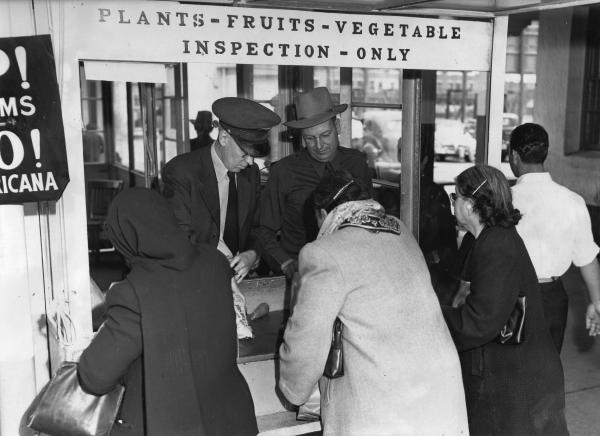
N-10608. Inspection: Pedestrians crossing the bridge must open their bundles for inspection. Inspector for Plant Quarantine Service (left) works with BAI inspector, who watches for animal products. ASI Archives Border Patrol Pictures. 10500D – 80202D. MS 178 Box 16.
Individual farmers also suffered major financial losses. The Mexican states of Sonora, Chihuahua, and Coahuila, for example, lost an export potential of 304,793 head of cattle valued at 32,417,365 pesos annually. (Machado, 1969) A subsequent reduction in meat consumption and trade threatened to destabilize the Mexican economy. Diets were affected, as people could not rely on beef or dairy products. There was also a severe corn crop failure, due in part to a lack of cattle to plow fields.
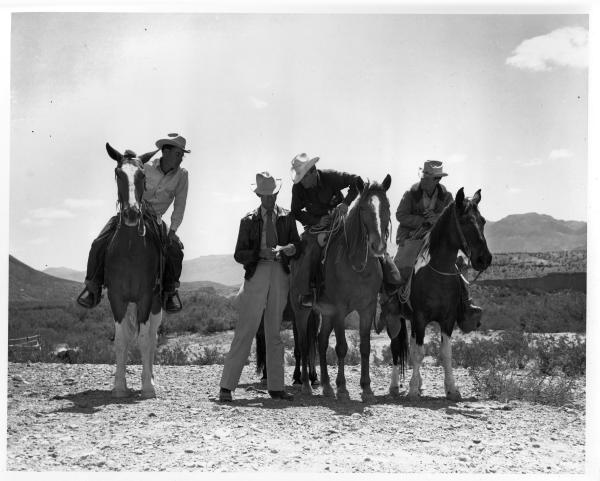
N-10765. Foot-and-mouth disease team on horseback. ASI Archives Border Patrol Pictures. 10500D – 80202D. MS 178 Box 16
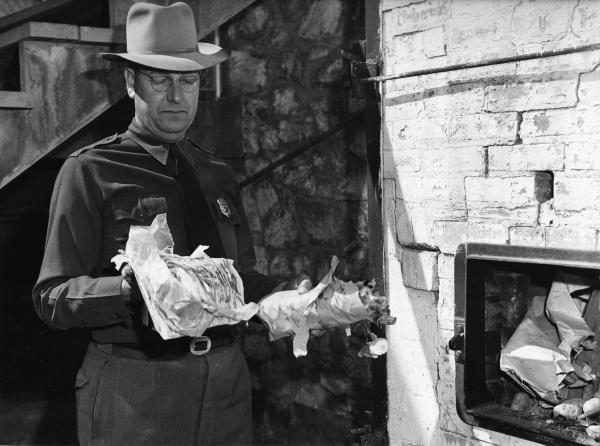
N-10737. Entry prohibited: meat discovered in parcels of persons crossing the border is confiscated by BAI Inspector Schultz. Meat is incinerated. ASI Archives Border Patrol Pictures. 10500D – 80202D. MS 178 Box 18.
As the virus spread throughout Mexico, a few Texan ranchers wanted to build a wall as a form of protection. Instead, the United States and Mexican government worked on an agreement to battle the disease together:
"Mexican officials traveled to Washington, D.C., to request U.S. aid in combatting its spread. Recognizing the threat to the U.S. cattle industry if the disease crossed the border, negotiations for aid moved quickly, and on February 25, 1947, President Harry Truman signed a bill into law authorizing the Secretary of the United States Department of Agriculture (USDA) to implement any feasible program that would keep the virus out of the United States. On March 18, representatives from the U.S. Department of State and the Secretaría de Relaciones Exteriores (Mexican Secretary of Foreign Relations) signed an agreement, creating the Mexican-United States Commission for the Eradication of Foot-and-Mouth Disease, also known as the Comisión México-Americana para la Eradicación de la Fiebre Aftosa (CMAPEFA)." (Mendoza, 2015, p. 39)

Increasing the Security of the United States from Foot-And-Mouth Disease Through Research Pamphlet. USDA Foot-and-Mouth Research Laboratory Records 1943-1956. Box 1 of 2. Research on Foot-and-Mouth Disease. Folder 1. 1948.
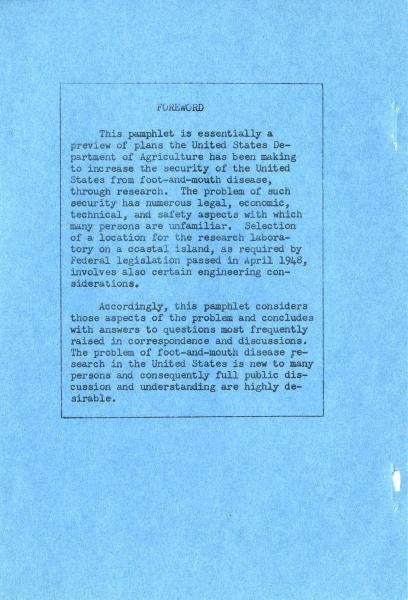
Increasing the Security of the United States from Foot-And-Mouth Disease Through Research Pamphlet. USDA Foot-and-Mouth Research Laboratory Records 1943-1956. Box 1 of 2. Research on Foot-and-Mouth Disease. Folder 1. 1948.
In his historical survey of this time period, “Aftosa: A Historical Survey of Foot-And-Mouth Disease and Inter-American Relations”, Manuel A. Machado Jr. chronicles Mexican eradication efforts, following suggestions from the United States government:
"[the approach included] inspection, slaughter of infected and exposed stock, deep burial, and rigid disinfection of people and vehicles going across the border and quarantine, known in Mexico as the Aleman-Ortiz Garza plan. The Mexican Army provided quarantine stations, transportations, and police control for the sanitary brigades, and local juntas municipals (municipal directorates) and regional cattleman’s organizations in the affected areas gave immediate promises of support to the National Commission." (Machado, 1969, p. 40)
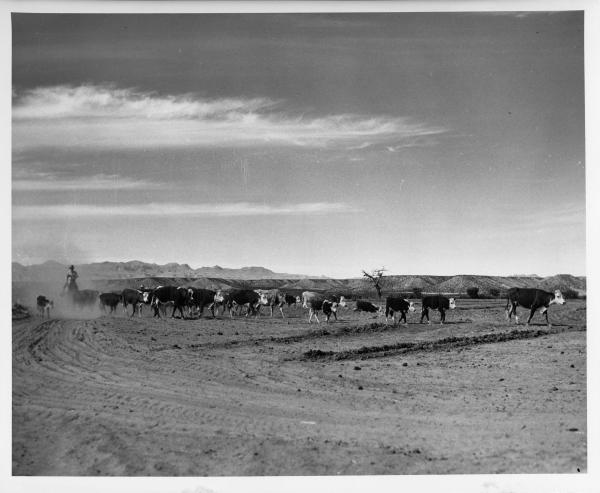
N-10725. Round-Up: nearest ground patrolman is notified to round suspicious herd for close examination. ASI Archives Border Patrol Pictures. 10500D – 80202D. MS 178 Box 18.
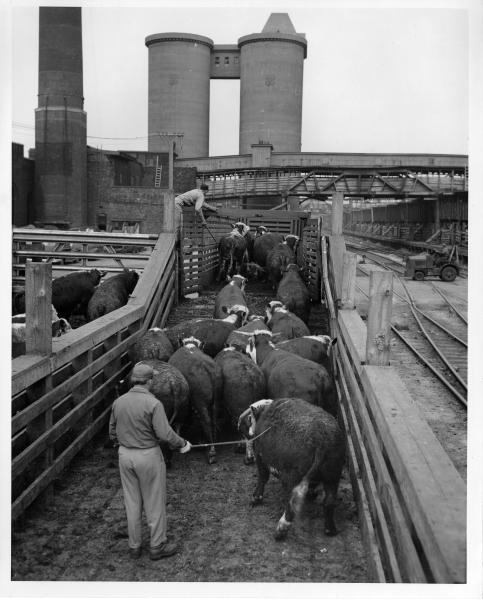
Men rounding up cattle. ASI Archives Border Patrol Pictures. 10500D – 80202D. MS 178 Box 16.
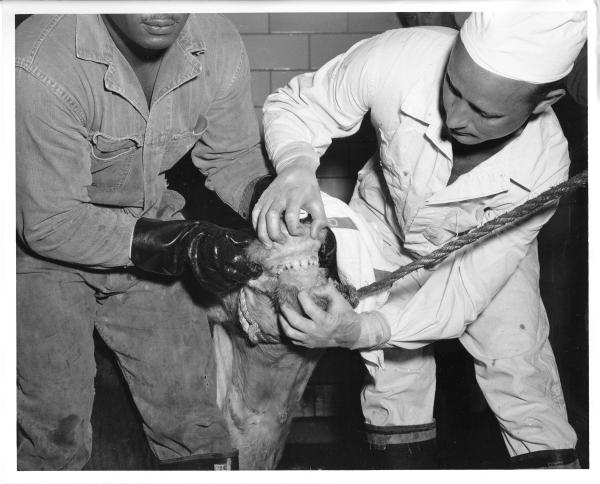
N-16360. Inspection of mouth area. ASI Archives Border Patrol Pictures. 10500D – 80202D. MS 178 Box 16.

N-16360. Inspection of hoof. ASI Archives Border Patrol Pictures. 10500D – 80202D. MS 178 Box 16.
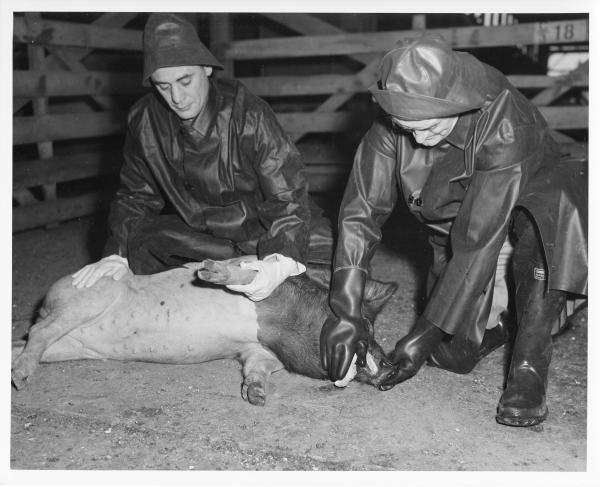
Men inspecting infected swine. ASI Archives Border Patrol Pictures. 10500D – 80202D. MS 178 Box 16.
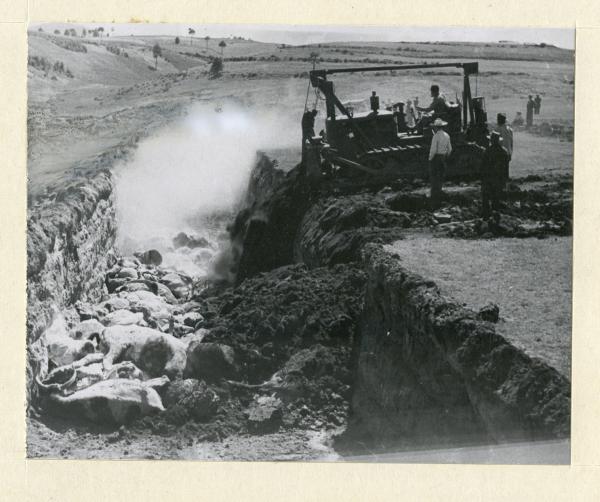
F. & M. – Mexico – 1947. 80203-B. Burying is done quickly with power machinery. ASI Archives Border Patrol Pictures. 10500D – 80202D. MS 178 Box 16.

F. & M. operations in Mexico – 1947. BAI-11249. Disinfecting equipment. Old Mexican Pix. ASI Archives Collection 178. Border Patrol Pictures. MS178, Box 30.
In December 1946, American and Mexican soldiers, ranchers, veterinarians, and propagandists entered Mexico, not just to help, but also to look for better economic prospects. In his article “Fighting Foot-and-Mouth Disease in Mexico: Popular Protest against Diplomatic Decisions,” John Ledbetter describes the events:
"As early as December 1946, [American and] Mexican soldiers, [ranchers], veterinarians, and propagandists, some hoping for better economic prospects, [entered Mexico]. Mexican officials were forced to begin an intense educational program. Rural teachers received word to instruct their neighbors; the federal government printed warning pamphlets. In the spring of 1947 Mexicans and Americans began to work the infected areas together." (Ledbetter, 2001, p. 398)
Propaganda items included official health fliers, brochures, tours from national and regional governments, radio broadcasts, bulletins, pamphlets, appeals from clergy, speakers on trucks run through towns, films, and cultural brigades in an attempt to unify rural farmers in agreement with national interests and protocols. Monetary compensation was also given to campesinos for the loss of their livestock ("campesino" roughly translates to "peasant" in Spanish [or farm worker, peasant farmer, peasant farm worker, etc.] except it has a more dignified connotation.) (High Steaks at the Border)
Machado describes the lead-up to a shared program to protect U.S. interests:
"United States livestockmen favored aid to Mexico because the [Foot-and-Mouth Disease] threat presented a real and present danger to their own interests. Congress rushed through a bill authorizing the Secretary of Agriculture to give aid to Mexico in order to protect United States interests. The Mexican-United States Agricultural Commission met and agreed on a mutually acceptable program. Their recommendations included the creation of a joint commission based in Mexico City with a Mexican director and a United States co-director. The Mexican military was given complete police power in enforcement of Commission requirements." (Machado, 1969, p. 41)
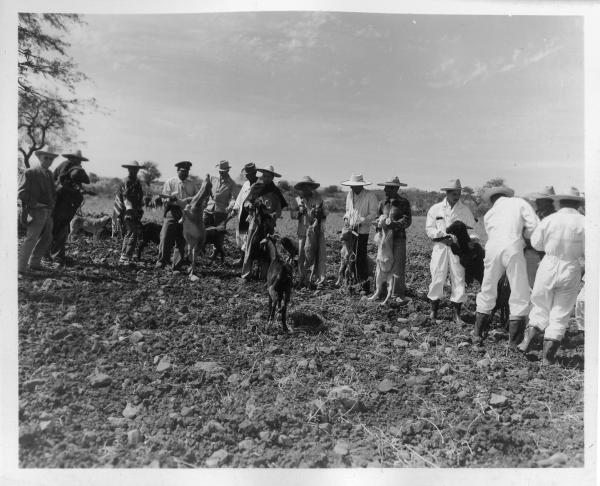
Dr. Shahaw photo of goat inspection. ASI Archives Border Patrol Pictures. Collection 178. Box 30.
Quarantine measures were also put in place:
"Mexico was divided into zones, described as infected, buffer, and clean, and all animal transportation became subject to strict quarantine regulations under the direction of Commission veterinarians. Additionally, animals within an infected zone could not move to other regions, and products of livestock in the afflicted area were refused transport out of the zone." (Machado, 1969, p. 41-42)
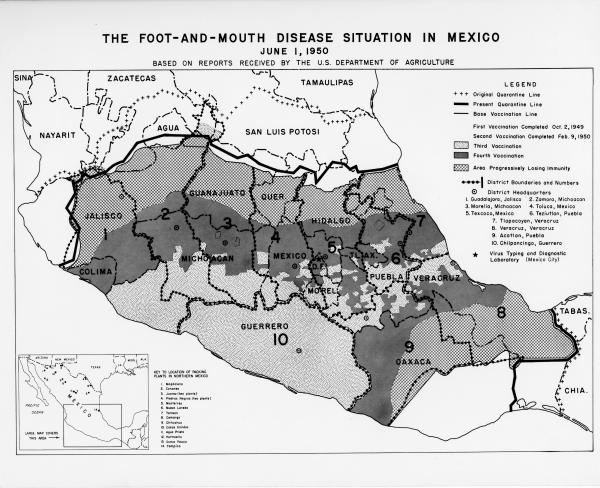
Map of Foot-And-Mouth Disease Quarantine Zones in Mexico. Historical Photography. Row 5 Draw 1, 23. Foot-and-Mouth Disease. Folder 1.
Although transnational collaboration was underway, efforts were complicated by various factors when working with campesinos’ livestock. One complication was the movement of campesinos and their herds across quarantined zones in Mexico, which further spread the disease. (Machado, 1969) Rath explains that quarantine zones proved difficult to enforce and track:
"Earlier censuses and maps proved unreliable, and people’s propensity to hide animals, the opaque nature of peasant practices of land-holding, informal grazing arrangements and the shifting, ad hoc nature of the roads along which livestock traveled made this information hard to obtain." (Rath, 2020, p. 771)
Officials also claimed that campesinos were reportedly annoyed by the mules’ temperament, as they were used to working with docile cattle, and machinery would be damaged by the mules’ working pace. (Fox, 1997) Mules were not an effective replacement for the cattle needed for the campesinos’ work.
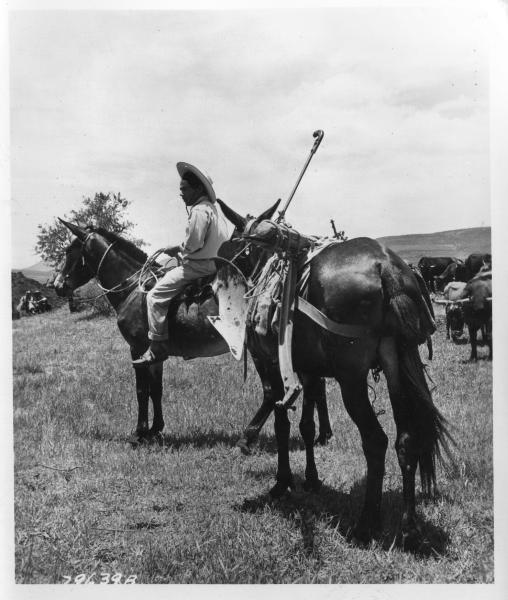
F. & M. – Mexico – 1947. 79639-B. Mexican farmer on his way home with his new mules, harness, and plow.
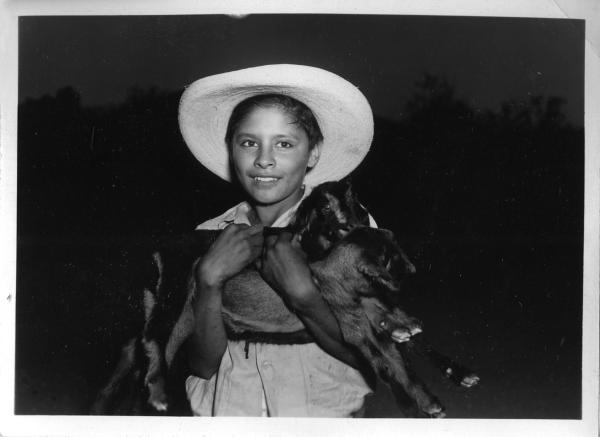
F. & M. Pix Mexico – From McClarren 12-8-49. Boy holding kids. ASI Archives Collection 178. Border Patrol Pictures. MS178, Box 30.
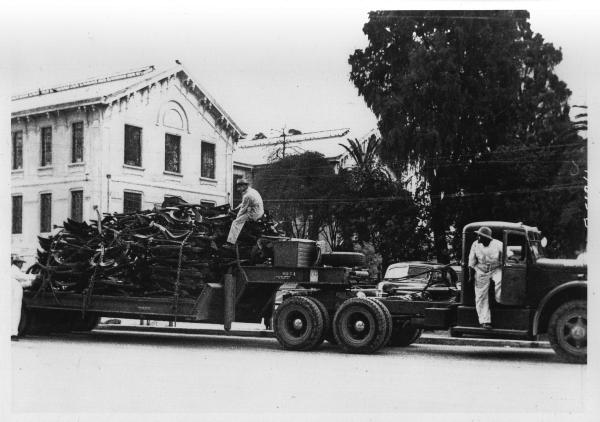
F. & M. – Mexico – 1947. BAI 79675-B. Old Mexican Pix. Steel plows to replace wooden ones. ASI Archives Border Patrol Pictures. Collection 178. Box 30.
Such perceived complications pointed to more substantial frustrations of campesinos with the apparent inconvenience of eradicating the disease: locals in the countryside were bearing the brunt of the cost of lost livestock using the slaughter tactic. As campesinos lost their livelihoods due to the killing of their cattle, it made life much more difficult. They preferred to test the animals first, but the slaughter tactic was the default method of dealing with the outbreak, heavily enforced by the Mexican-United States bilateral cooperation. Further, Machado notes that, although campesinos were compensated for the loss of their livelihood, there were many problems they faced with this:
"Equitable compensation proved a problem for CMAPEFA, and before the creation of that body the National Commission found itself without sufficient funds for adequately compensating the livestock raisers. Minimum compensation standards were established, but bureaucratic snarls involving the provision of funds hindered efficient operation. Finally, joint handling of funds was decided upon, with the United States paying the bulk of the compensations." (Machado, 1969, p. 42)
Frustrations from campesinos were at times met with disdain and even condescending remarks from officials who demanded full cooperation. This fraught relationship is further revealed by C.J. Alvarez in his article, "The U.S.-Mexico Border and the 1947 Foot-and-Mouth-Disease Outbreak in Mexico." Alvarez says:
“[From a senior U.S. official from the bilateral commission describing their troubles in the countryside]: If we could deal only with the big cattlemen the task would be relatively easy. In fact, many of them without any compensation are devoting their entire time and energies to assistance.” (Alvarez, 2019, p. 698)

F. & M. Pix Mexico – From McClarren 12-8-49. Veterinarians and military personnel speaking with rural farmers. ASI Archives Collection 178. Border Patrol Pictures. MS178, Box 30.
Rath highlights how even efforts to improve records and maps of quarantined zones revealed deep resentment and even stereotypes directed toward campesinos:
"These reports reproduced many long-standing official ideas and stereotypes about Guerrero’s geography. One information man, Federico Sánchez, divided the state into four conventional geographic areas (the costa grande, costa chica, the tierra fría of the central highlands, and tierra caliente); each area offered distinctive cultural and ethnic obstacles to state action, but particularly the coastline—filled with men accustomed to laziness and criminality—and the tierra caliente: the most dangerous area, infested with cattle-rustling, banditry and blood feuds. Still, amid the geographic cliché and ethnic stereotypes, Sánchez also gathered new information about attitudes to vaccination, lists of more or less cooperative towns, and key powerbrokers and institutions in the state." (Rath, 2020, p. 771-772)
Alvarez also describes how the commission depended heavily on the Mexican military to do its work:
“The increasingly coercive police responses in the 1940s were predicated on the notion that border policing might require mechanisms of social control in places that were in fact a great distance from the international divide itself.” (Alvarez, 2019, p. 698)
The contrast of the working relationship among the campesinos in the rural countryside and that of officials at the international border further reveals that, even though the United States and Mexico were able to come into agreement about how to deal with foot-and-mouth disease in a unified manner (even if the image of such a unified front may have been glossed over), this did not seamlessly translate into an easy relationship when working with locals.
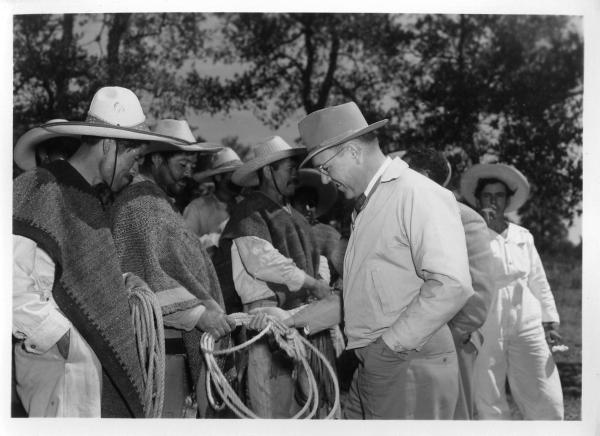
F. & M. Pix Mexico – From McClarren 12-8-49. Official handling rope. ASI Archives Collection 178. Border Patrol Pictures. MS178, Box 30.
Rath chronicles the full extent of disruption of the slaughter tactic to eradicate the disease, further reporting reasons behind the bubbling anger among campesinos:
"In 1949, the Mexican government began to offer some sporadic credit, breeding stock and technical advice to help farmers devastated by the disease and slaughter. However, the evidence suggests that this repopulation program was beset by political [favoritism] and focused on large commercial ranchers. In the summer of 1947, US and Mexican officials had pondered whether the campaign should move beyond individual indemnities and provide an integrated program of rural credit, education and public works to help affected communities, but such a program never emerged. One recurrent cause of tension was the initial diagnosis of disease outbreaks, since it crystallized very different understandings of risk. The early clinical symptoms of FMD among cattle were very hard to distinguish from relatively harmless cases of vesicular stomatitis. US veterinarians were instructed to assume the worst in all new outbreaks, and proceed to slaughter; Mexican veterinarians were more circumspect, preferring to recommend quarantine measures and wait until laboratory tests confirmed the presence of FMD. Again, these disputes produced numerous irate telegrams and phone records in the US archive, but Mexican veterinarians often preferred to keep discussions off-the-record." (Rath, 2020, p. 781)
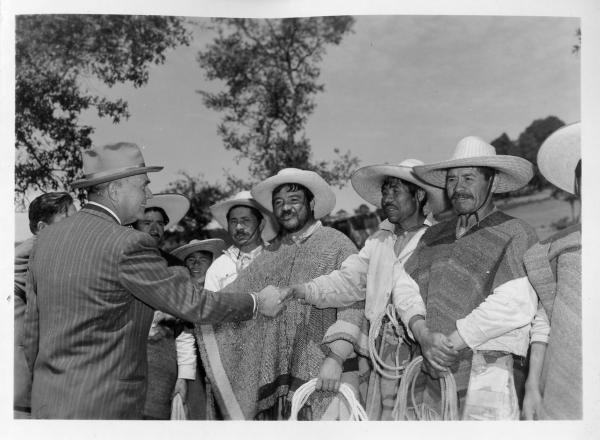
F. & M. Pix Mexico – From McClarren 12-8-49. Official shaking hand of campesinos. ASI Archives Collection 178. Border Patrol Pictures. MS178, Box 30.
Violent protests erupted in different Mexican states, and the threat of larger political unrest loomed as a result of disagreements, government and military coercion, and delays in fully providing for the economic and agricultural needs of campesinos. Soldiers and veterinarians were sometimes killed as a result, and such extreme opposition was often led by people who disapproved of the United States’ efforts and work with the Mexican government, blaming them for mishandling the outbreak:
"The violence in the countryside [was] a response to an existential threat to their way of life as agriculturalists of limited means. Since these animals were difficult to replace even with indemnities, their deaths meant not only economic distress, but also ongoing calamity. From this point of view, the killing of soldiers was a response to acts of violence first perpetrated by the state. And to Mexican intellectuals, the state-sponsored violence of the slaughter campaign was all the more outrageous because of the heavy influence of U.S. scientists, businessmen, and politicians." (Alvarez, 2019, p. 702)
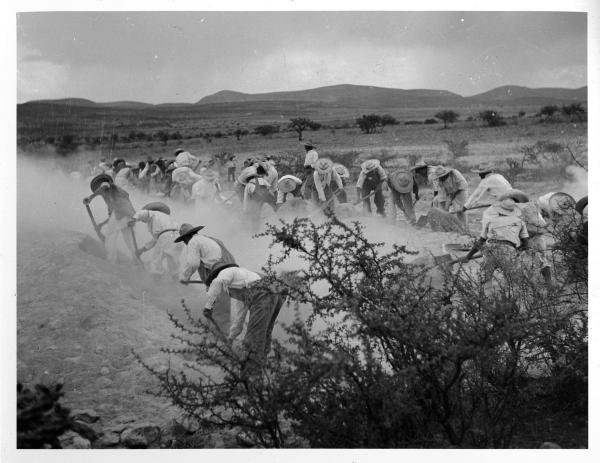
F. & M. – Mexico – 1947. 11251 – A. Old Mexican Pix. Spreading quicklime over slaughtered cattle in trench. ASI Archives Collection 178. Border Patrol Pictures. MS178, Box 30.
Such opposition to the United States’ work with Mexico meant that “Mexican officials obeyed bilateral agreements in principle but dragged their feet on operations in politically sensitive regions.” (Rath, 2020, p. 781) Rath notes:
"Over time, such everyday bureaucratic infighting threatened to undermine the carefully cultivated image of Pan-American harmony and orderly bilateral negotiations between two coherent states. Moreover, Mexican officials were always wary of appearing to bend excessively to US demands. Tellingly, disputes in the commission [were] omitted." (Rath, 2020, p. 781)
In Machado’s writing, we see an example of how religion also influenced this opposition:
"Rural Mexican religion [includes] Holy Days, Saints’ Days, [paganism], and other religious festivals. This form of veneration led to an unusual situation in Guerrero when peasants refused to corral their stock for vaccination and inspection. They stated that the animals were corralled but once a year, on October 18, San Lucas’ Day. Therefore, with the support of the Mexican Army, the brigades were forced to capture, inspect, and vaccinate the cattle at different water holes [without support from the locals, and on a day other than October 18]." (Machado, 1969, p. 52)

F. & M. Pix Mexico – From McClarren 12-8-49. Officials speaking with campesinos. ASI Archives Collection 178. Border Patrol Pictures. MS178, Box 30.
Over time, the bilateral commission figured out that they needed to quickly appease the concerns and frustrations of campesinos and find more effective disease control solutions in order to save the rural economy in Mexico, prevent further clashes between locals and government forces, and maintain an image of unity between the two countries and within the Mexican government. As a result, CMAPEFA sought to change its disease eradication tactic to a slaughter-vaccination combination tactic.
Soon, efforts to fight foot-and-mouth disease included even more international influences. Advisors and vaccine samples from England, Holland, Switzerland, Argentina, and Denmark arrived for effective vaccine experimentation. (Machado, 1969) Vaccination experimentation sites were chosen and built in Mexico and the United States.
In Mexico, this included sites at San Jacinto, Santa Ana, Rastro San Angel, and Palo Alto. (Machado, 1968) The United States vaccine experimentation labs included Plum Island Animal Disease Center in New York, which was established in response to disease outbreaks in both Mexico and Canada in 1954. The United States Army gave the island to the USDA to establish a research center dedicated to the study of foot-and-mouth disease in cattle. (The Wall Street Journal, 2001)
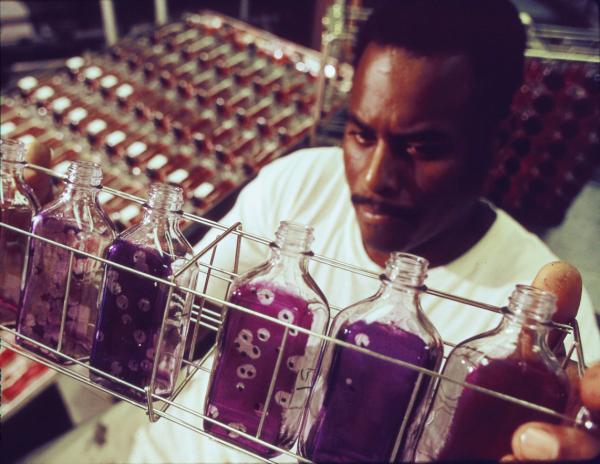
Plum Island. A technician conducts experiments on foot-and-mouth disease to find the number of virus particles in blood from infected cattle. Scientists study foreign animal disease that could devastate this country’s livestock. Historical Photography. Row 5 Draw 1, 23. Foot-and-Mouth Disease. Folder 1.
By 1948, vaccine production was sufficient enough in Mexico to stop the imports of vaccines from abroad. (Machado, 1969) However, people were wary of cooperating with the new measures against foot-and-mouth disease. Disinformation about the vaccine had also spread throughout rural Mexico, including one rumor that eating products from vaccinated animals would lead to sterilization in people. (Machado, 1968) Yet, as Machado and Ledbetter explain, the vaccination and rehabilitation campaigns prevailed:
“Each animal was vaccinated a minimum of three times and most of them received four doses at intervals of three or four months. [This was especially important as newborns of vaccinated animals also needed to be vaccinated, and emerging variants and the loss of immunity over time further necessitated newer versions of the vaccine and multiple doses.] Through both the importation and the manufacture of the vaccine, a ready reserve was maintained in case of emergency. The site of Palo Alto also became an artificial insemination center through which the livestock industry in the infected zone was rehabilitated, as foot-and-mouth disease had rapidly depleted the cattle and livestock population in Mexico." (Machado, 1968, p. 39 & 81)
And in Ledbetter’s account:
“Despite setbacks, by mid-1948 the countries had turned the battle against foot-and-mouth disease. Throughout that year and the next, the campaign continued repeated vaccinations [to combat increasingly smaller] outbreaks, followed by the killing of infected livestock." (Ledbetter, 2001, p. 411)
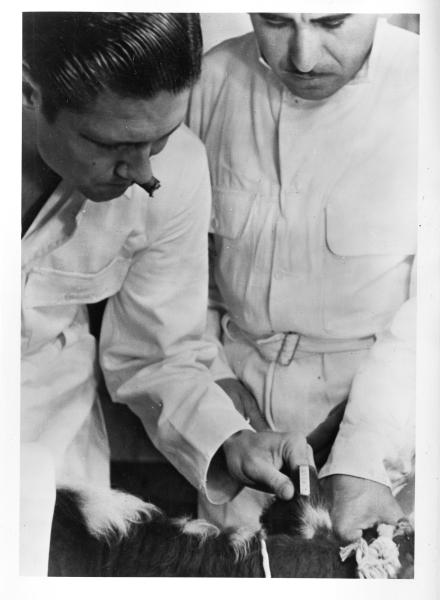
F. & M. – Mexico – 1948. 79994-B. Reading test animals ear tag in the production of vaccine. ASI Archives Border Patrol Pictures. 10500D – 80202D. MS 178 Box 16.
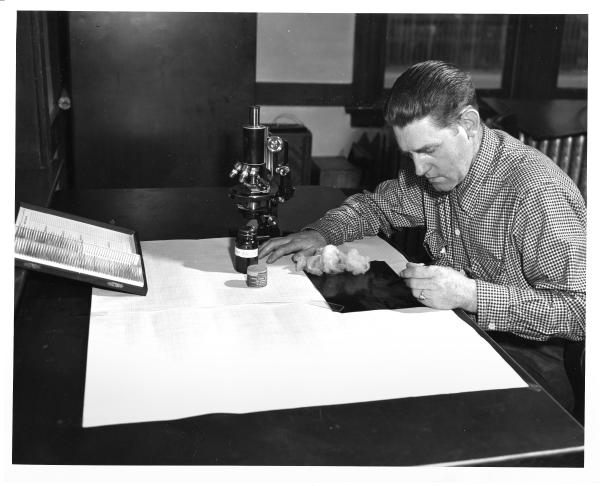
Man working on vaccine. ASI Archives Border Patrol Pictures. 10500D – 80202D. MS 178 Box 16.
Through much collaboration and despite various setbacks, foot-and-mouth disease was beginning to disappear, reflecting the success of international collaboration on scientific and political fronts:
“Participation by the United States was motivated by national interest, for it [was] feared that the disease would sweep northward and devastate the livestock industry of the Southwest, if not other regions. Yet, this very complicated history and approach to foot-and mouth disease eradication brought Mexico and the United States closer together and contributed significantly to an improvement of Mexican-United States relations. [Furthermore], Mexico and the United States [together] made a unique scientific contribution to the eradication of foot-and-mouth disease." (Machado, 1969, p. xiii - xiv)
Machado further summarizes this outcome:
Overall, more than 60,000,000 injections were administered to livestock by the end of 1950 for both Type O and Type A strains of the disease, a sign that United States–Mexico relations were improving in the post-World War II era. (Machado, 1969)
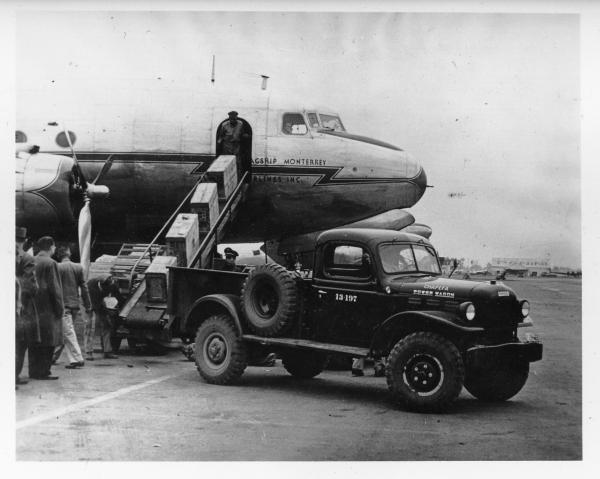
F. & M. – Mexico – 1947. 79668-B. Vaccine arriving in Mexico. ASI Archives Border Patrol Pictures. 10500D – 80202D. MS 178 Box 16.
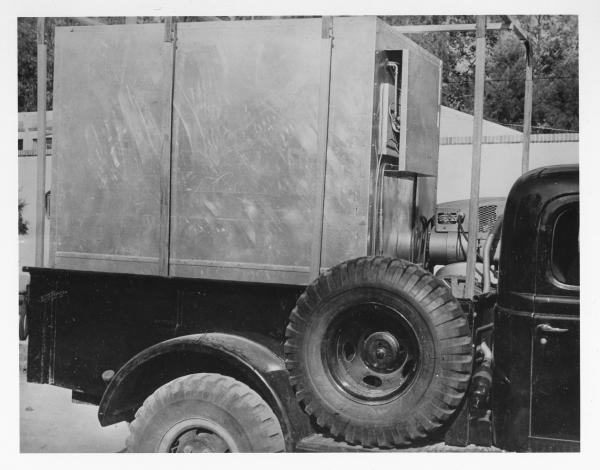
F. & M. – Mexico – 1948. 79982-B. Mechanically refrigerated truck for transporting vaccine. ASI Archives Border Patrol Pictures. 10500D – 80202D. MS 178 Box 16.
The aftermath of the campaign signaled an improvement in bilateral relations between the United States and Mexico, as well as improved infrastructure for the Mexican government and society. Rath writes:
"Many Mexican officials and scientists resented the campaign’s early reliance on slaughter and the disruption it caused, but it did allow them to reshape Mexican state institutions. Over time, the commission’s improved knowledge of topography, ranching practices and livestock movements allowed it to create far more effective and enforceable quarantine lines. In 1948–9, commission officials engaged in repeated waves of inspections and vaccinations created a more accurate census of livestock. By the early 1950s, with US assistance, Mexico had installed an extensive radio system linking the Ministry of Agriculture’s various stations across the countryside, boosted veterinary training and numbers, organized a system of lay disease inspection teams and built an up-to-date laboratory outside Mexico City to test disease samples sent in from the distant campo. Together these formed a new veterinary infrastructure and a somewhat weightier state presence in the countryside." (Rath, 2020, p. 772 - 773)
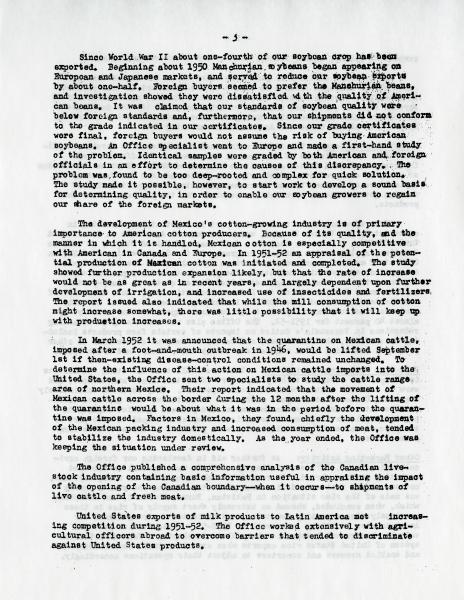
Allan P. Mustard Collection on Foreign Agricultural Services. Manuscript Collection 390. Box 2, Folder 17. Foot-and-Mouth Disease Annual Report of the Office of Foreign Agricultural Relations Fiscal Year, 1951-52. Page 3.
Rath lauds the thoroughness of record keeping in the Mexican government that came about:
"Despite a host of problems, by the early 1950s the CMAEFA had gathered a formidable body of data ... everyday operational correspondence and radio logs, detailed records of sanitary inspections, slaughter, indemnities and vaccination drives by town and village. Indeed, this was the kind of information usually welcomed by the state for the purposes of tax collection, social and sanitary control, and political management. Similarly, records would have contained a wealth of valuable sociological information, including: the livestock owners affected [by the disease], their backgrounds, and scale of operations, not to mention detailed records of [more- or less-] cooperative regions, villages and subnational authorities." (Rath, 2020, p. 774)
Despite the archive’s great value, the Mexican government purposefully destroyed the archive in a fire. Rath describes how periodic and intentional destruction of archives by government institutions was not uncommon. However, this particular case seemed to be a calculated tactic:
"[The decision to destroy the archive was driven by] a calculation of the political benefits and risks of keeping it. The different types of corruption that structured the FMD campaign—and which could be directly traced to commission officials—were probably [of] most immediate concern. The campaign provided abundant opportunities for government in the service of graft, and was plagued by accusations of peculation and extortion, particularly during the phase of slaughter. Indeed, the only official document mentioning the archive fire came in response to an enquiry by Fernando Morales Henestrosa, a rancher’s son, who disputed one of the many fines imposed by the commission on non-cooperative livestock owners. Many other accusations of local and state officials involved in similar schemes show up in US field reports, Mexican complaints and official memoirs." (Rath, 2020, p. 778)
Interactive History of Foot-and-Mouth Disease
A podcast provides a more thorough narrative of this period in Mexico’s and America’s history, featuring Mendoza. The podcast, High Steaks at the Border, is part of Distillations at the Science History Institute, a podcast and multimedia magazine. The podcast includes a transcript to follow along with the historical narrative, as well as research notes to further explore the topic. The research notes include a link to Texas Cattle Fever, a section of the digital exhibit, USDA'S Contributions to Veterinary Parasitology, under NAL Special Collections Exhibits.
The podcast captures the nuanced experiences of veterinarians and Mexican farm workers throughout the foot-and-mouth disease campaign, further revealing the complexities of contexts interwoven into this history. The podcast also highlights the tense atmosphere that local farmers had to sift through while trying to cooperate and navigate quarantine, slaughter and compensation efforts:
"There were military checkpoints everywhere. Mexico was already coming off a series of peasant revolts from years prior. Things were adding up and to make matters worse, disaster vultures started exploiting the crisis. You have lots of scams going on where people are coming in before the commission comes into a community and saying, 'these people are just going to take your animals and kill them. But if you sell them to us, even at very low, low prices much below what the animal is worth. You can at least get some money for them.' And so people would sell their animals for little prices [and] the commission would get there and be like, 'we would have paid you more for your animals, plus now those animals are somewhere else. We don't know if they have foot-and mouth-disease.' Popular county fairs were cancelled. People were very, very desperate. And there were these groups of people who didn’t even buy the crisis. They thought it was a government conspiracy." (High Steaks at the Border)
Even with these agricultural, economic, and social and cultural tensions, what ultimately eradicated foot-and-mouth disease in Mexico was cooperation:
"The work on the ground that’s done by the government, by veterinarians and livestock owners who, many of them who might be resistant at first, but as the events wear on are more and more readily contacting the government saying, 'I have a suspected case of ffoot-in-mouth disease, come check out my animals' and, you know, figure out what we need to do." (High Steaks at the Border)
The “negotiation and compromise of the foot-and-mouth campaign [provides an] illustration of the ongoing reinterpretation of national relations.” (Ledbetter, 2001, p. 388) Analyzing this history is not about studying merely government, vaccines, border patrol, the environment, society and culture or animal health in a siloed manner. Instead, weaving aspects of this history together attempts to reveal the experiences within the narrative, providing revelation to capturing a fuller picture of this unique relationship between Mexico and the United States.
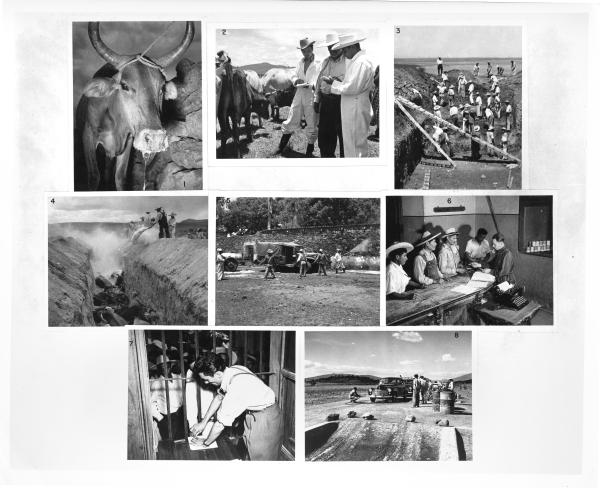
Photo collage of foot-and-mouth disease. Historical Photography. Row 5 Draw 1, 23. Foot and Mouth Disease. Folder 1.
Digital Gallery created by Karen Adjei, NAL Fellow
Primary Source Materials Used at NAL:
Allan P. Mustard Collection on Foreign Agricultural Services. Manuscript Collection 390. Box 2, Folder 17.
ASI Archives Border Patrol Pictures. 10500D – 80202D. MS 178 Box 16.
ASI Archives Border Patrol Pictures. 10500D – 80202D. MS 178 Box 18.
ASI Archives Border Patrol Pictures. Collection 178. Box 30.
ASI Archives Collection 178. Border Patrol Pictures. MS178, Box 30.
Historical Photography. Row 5 Draw 1, 23. Foot and Mouth Disease. Folder 1.
USDA Foot and Mouth Research Laboratory Records 1943-1956. Box 1 of 2. Research on Foot and Mouth Disease. Folder 1. 1948.
Secondary Source Materials:
Alvarez C.J. 2019. “The U.S.-Mexico Border and the 1947 Foot-And-Mouth-Disease Outbreak in Mexico.” Journal of the Southwest 61 (4): 691–724. DOI: 10.1353/jsw.2019.0039.
Animal and Plant Health Inspection Service. 2022. USDA Under Secretary Jenny Lester Moffitt Visits Mexico to Celebrate 75 Years of Mexico-U.S. Commission for Prevention of Foot-and-Mouth Disease and Other Exotic Animal Diseases. United States Department of Agriculture, News and Announcements. Accessed February 11, 2023.
Fox, Kel M. 1997. “Aftosa: The Campaign against Foot-And-Mouth Disease in Mexico, 1946-1951.” The Journal of Arizona History 38 (1): 23–40.
Gutiérrez, N. 2023. 200 Years of Bilateral Relations with Mexico: Protecting Agricultural Resources from Plant Pests and Animal Disease Threats on Both Sides of the Border. United States Department of Agriculture. Accessed February 11, 2023.
Jeanne, I. 2002. Bioterrorism Fears Revive Waning Interest In Agricultural Disease Lab on Plum Island. The Wall Street Journal. Accessed February 11, 2023.
Ledbetter, J. 2001. “Fighting Foot-And-Mouth Disease in Mexico: Popular Protest against Diplomatic Decisions.” Southwestern Historical Quarterly 104 (3): 386–415.
Machado, Manuel A. 1969. Aftosa: A Historical Survey of Foot-And-Mouth Disease and Inter-American Relations. Albany: State University of New York Press.
Machado, Manuel A. 1968. An Industry in Crisis: Mexican-United States Cooperation in the Control of Foot-And-Mouth Disease. University of California Publications in History, V. 80. Berkeley Calif.: University of California Press.
Mendoza M.E. 2015. “Battling Aftosa: North-To-South Migration Across the U.S.-Mexico Border, 1947-1954.” Journal of the West 54 (1): 39–50.
Rath T. 2020. "Burning the Archive, Building the State? Politics, Paper, and US Power in Postwar Mexico.” Journal of Contemporary History 55 (4): 764–92. DOI: 10.1177/0022009419881189.
Science History Institute. 2019. High Steaks at the Border: When the United States and Mexico resolved their beef. Distillations, Episode 240. Accessed February 11, 2023.
